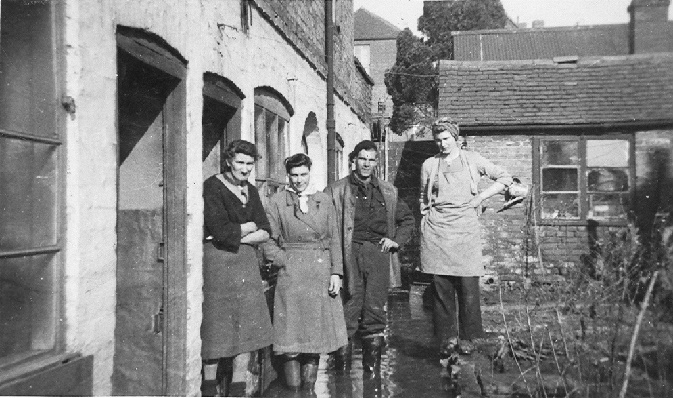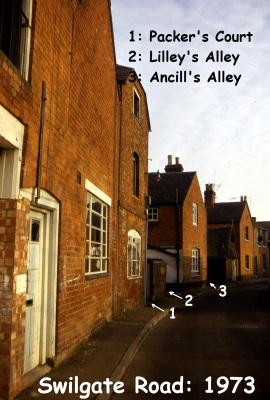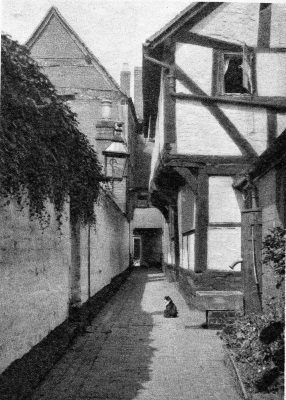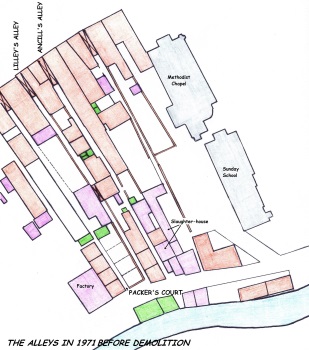Lilley's Alley

to Expand
In about 1805, Mrs Mary Lilley’s kept a china shop on Church Street, near the Cross, and has been immortalised in the name of the alley behind it; still one of Tewkesbury’s gems.
Mrs Lilley’s shop was one half of what is now ‘Replay’. She rented it from John Packer, a wealthy hosier, known as ‘Cork Leg’ Packer because of his artificial leg. He owned a great deal of property in Church Street and elsewhere in the town. The doorway to the right of Jennings Carpets was once an entrance to Packer’s Court, though the public entrance was from the Swilgate end. The Court was latterly known as Yew Tree Cottages.
When John Packer died suddenly in 1855 the inquest decided that he’d died by ‘the visitation of God’. His property was left in a Trust administered by his family. This led to a dispute with Lechmere’s Bank who called in a mortgage. It eventually escalated to a case in the Court of Chancery and the sale of the estate in order to pay Lechmere’s Bank and the heavy legal costs which they had incurred.
to Expand
Among the properties advertised for auction in 1870 were ‘two capital front dwelling houses with the brewhouse and stable in Lilley’s Alley’, the one lately occupied by William Morse (butcher) and the other tenanted by Thomas Matty (fishmonger) (these together are now ‘Replay’); Two commodious cottages adjoining, one lately in the occupation of William Morse and used as a stable, and the other untenanted; a convenient cottage late in the occupation of William Baldwin, also situate in Lilley’s Alley but now void.’
Two years later, the front house was occupied by John Gannaway, butcher, at £18 pa and Mr Haines, hairdresser, at £12.In 1875, Mr C. Dowswell bought the property and the two cottages behind for £259; the cottages accounting for £34 of that.
The alley suffered from the same problems as most of the alleys; overcrowding and poor water. Because of contamination, the well was ordered to be pumped out, twice, in 1877 but it was still causing concern in 1937. The pump was a feature of the alley captured in photographs and paintings, but it had been removed by 1938, when a piped water supply was laid on.

In 1911, the residents petitioned the Council for a gas lamp, and this was granted. The lamp was not always reliable (or maybe the lamp-lighter wasn’t) and in 1930 it was replaced by an electric one.
In common with the other alleys stretching down to the Swilgate Road, there were tragedies with young children drowning. The safety logic seemed to be that there were always children playing there, so help would quickly be sought if someone fell in. It worked in 1904 when Mr Deveraux’s five-year-old daughter was rescued by Stephen Healy, working in the slaughterhouse in Ancill’s Alley nearby, but not for four-year-old Mary Ann Maycock, who drowned there in 1951. These alley tragedies were the reason why fundraising for an indoor swimming pool was so important to residents.
Lilley’s Alley didn’t suffer the wholesale demolition of the post-war clearance programme of other alleys. Cottages were consolidated; the two cottages sold in 1875 are now Tudor House. ‘Claypipes’, further down the Alley, incorporates another cottage. Until 1972, the alley was almost unchanged from the Victorian version.
In 1971, the Lilley’s Alley Clearance Area Compulsory Purchase Order was issued. This was to enable the construction of a block of flats at the bottom of the alley. The purchase swallowed up Yew Tree Cottages in their little court and changed Ancill’s Alley into a private court entered from the Berkeley Arms side door. It also involved the demolition of the three cottages at the Swilgate end of the Alley. Though the character of the alley changed, the developers limited the damage by using sympathetic materials, such as blue bricks for paving.
Pigot’s Directory of 1830 lists Miss Cecilia Cooper, proprietor of an academy in Lilley’s Alley. Her writings suggest that this was the house at the Swilgate end. She was a poet of the romantic era, and in 1820 had published a poem entitled ‘The Battle of Tewkesbury’. This, and her school, are now distant memories, her home being a victim of redevelopment.
Census Data 1841-1891
- died 24-04-1870 and buried in Congregation Chapel graveyard
- Alice Davis;
- Lodger Listed As Schedule 017
- See Schedule 016
- Edwin Insall died aged 79 On 21st Sept. At Church Street (TREG 24/09/1892)
- note: Jesse And Richard Are Listed As Twins.
- War: H M A S Australia sank in national ceremony. Mr Walter James Glover of Lilley's Alley finished 26 years service in British Navy on board. TREG 19/04/1924 p3/4




Comments